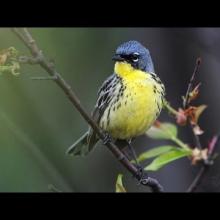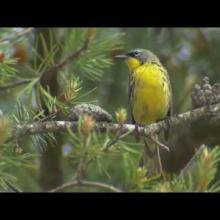

Join BirdNote tomorrow, November 30th!
Illustrator David Sibley and actor H. Jon Benjamin will face off in the bird illustration battle of the century during BirdNote's Year-end Celebration and Auction!
The climate of the earth is changing rapidly, and birds are responding accordingly. Of the 305 species found in North America in winter, nearly 60% have shifted their ranges northward by an average of 35 miles. As some places become unsuitable for the birds now living there, new areas will become available. We can anticipate these changes and begin to improve those sites. For example, the rare Kirtland's Warbler breeds only in young jack pines in Michigan, Wisconsin, and Ontario. To help the warblers in the future, biologists now plan to introduce them into suitable habitat farther north. New stands of young pines there may be optimal places for the warblers as the climate warms.
BirdNote®
Birds and Climate Change - Preparing Places to Go
Written by Gordon Orians
This is Bird Note.
[Sounds of internal combustion engines in a city]
The climate of the earth is changing rapidly, as we burn fossil fuels at a rate faster than nature can remove the emissions from the atmosphere. Birds are responding accordingly. Of the 305 species found in North America in winter, nearly 60% have shifted their ranges northward by an average of 35 miles. Many birds are migrating earlier and laying their eggs earlier in the spring. [Dawn song]
Not all bird species will be able to adapt. But birds have survived past dramatic changes in climate. And there are ways we can help them.
As some places become unsuitable for the birds now living there, new areas will become available. We can anticipate these places and begin to improve them. [Song of the Kirtland’s Warbler]
For example, the rare Kirtland’s Warbler breeds only in young jack pines in Michigan. (Editor's note: Happily, more recently, the warbler is also nesting in Wisconsin and Southern Ontario.) By regularly burning the stands of pine and by controlling parasitic Brown-headed Cowbirds, managers have increased the population from fewer than 200 pairs to more than 700 pairs today. But to help the warblers in the future, biologists now plan to introduce them into suitable habitat in northern Michigan, Wisconsin, and Ontario. New stands of young pines there may be optimal places for the warblers as the climate warms. [Song of the Kirtland’s Warbler]
There’s more about bird conservation in the face of climate change, at our website, BirdNote.org. [Song of the Kirtland’s Warbler]
###
Song of the Kirtland’s Warbler [73997] recorded by G.A.Keller and provided by The Macaulay Library of Natural Sounds at the Cornell Lab of Ornithology, Ithaca, New York.
The Dawn Song was recorded at Carnation Marsh by Martyn Stewart of naturesound.org
BirdNote’s theme music was composed and played by Nancy Rumbel and John Kessler.
Producer: John Kessler
Executive Producer: Chris Peterson
© 2016 Tune In to Nature.org February 2013/2016/2019 Narrator: Michael Stein
ID# climatechange-01-2013-02-28climatechange-01





